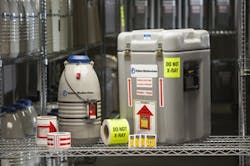There are many things to consider when shipping your high-value, temperature sensitive products using a cold chain logistics process. These range from complying with regulatory standards set by the International Air Transport Association (IATA), Department of Transportation (DOT), Transportation Security Administration (TSA), and U.S. Customs and Border Protection (CBP), to including the correct domestic or international documentation to accompany your shipment on its journey. Our list of top 10 concerns and considerations in cold chain logistics will help increase your knowledge of the process, understand how to avoid the common pitfalls often made, and implement the necessary parameters to ensure your product arrives safely and intact to its final destination.
2. Domestic vs. International Documentation
There are several documents required when shipping internationally that don’t always apply to domestic shipments, which can make international shipments more challenging. A manifest provides detailed information regarding the contents of the shipment and is required for the package to pass seamlessly through customs. A commercial invoice declares the value of the shipment so that the receiving country can collect the associated duty. If shipping Category A product you may need to include a Dangerous Declaration of Shipment form. Additionally, depending on the country of destination, a certificate of origin or even a NAFTA certification may be needed. If any of the necessary documents are missing from a shipment there is a high potential that the shipment will be held in customs, potentially compromising the temperature sensitive products.
3. Shipping Hazardous Material by Air vs. Ground
Determining whether to ship hazardous material by air or ground is dependent on the shipment’s components, temperature, quantity, distance and cost. Shipments traveling by air follow the IATA standards, whereas ground shipments follow DOT standards. These regulatory systems have different requirements that may impact how you select your mode of transportation. For example, airplanes have a limitation on the amount of dry ice they can ship per plane. Both air and ground have the ability to transport your shipment; it’s just a matter of selecting the option that works best for you.
4. Category A vs. Category B Documentation
Depending on the type of hazardous material you’re shipping, it will fall into two categories; Category A or Category B. Material is classified as Category A if the material is transported in a form that, when exposure to it occurs, is capable of causing permanent disability, life threatening, or fatal diseases to otherwise healthy humans or animals. Material is classified as Category B if it is an infectious substance which does not meet the criteria for inclusion in Category A. The shipping requirements for Category A and Category B material vary, which makes it very important to properly classify the product prior to shipping.
5. Package Components and Concerns
There are a number of temperature mediums on which you can ship products; wet ice, gel pack, dry ice, LN2. The most important things to consider when selecting your shipment system is the product’s temperature requirement and duration. Based on those two factors, a qualified shipper can be selected that is able to meet your temperature specification and hold time, in both winter and summer conditions. This will help ensure that your material is transported at the correct temperature.
6. Transportation Security Administration (TSA) Approved Drivers
When transporting your product by air, there is a chance that your shipment will be opened or x-rayed as it passes through security or customs. TSA is a chain of custody process and approved system that can help reduce this risk. When operating within TSA processes, it’s requested that you utilize an approved courier that has been trained and audited in TSA regulations and has controls in place to ensure that the package isn’t compromised en-route.
7. Carrier Handling of Shipments
A major concern related to the handling of shipments is adherence to pictograms and orientation. A pictogram is an image placed on a shipment that indicates specific information about the contents of a package, such as temperature or the direction a package should be shipped (orientation). When using vapor phase LN2 containers and dry shippers, it is imperative that the carrier orients the package in the direction specified on the pictogram to maintain the container’s static hold time. For example, a dry shipper oriented upright typically holds a charge for 21 days, but if shipped upside down it may only hold for 3 days, thus damaging the contents of the package.
8. Dry Ice Replenishment
If a temperature-sensitive product is being shipped a long distance or internationally, it may require dry-ice replenishment. This means that throughout the product’s journey, it will likely need to stop at a location to have dry ice added to the container. By selecting a courier that has a global network of infrastructure, you can utilize a high-touch point chain of custody process that ensures the package is replenished and the temperature of your product is maintained throughout its journey.
9. Liquid Nitrogen and Shipping
Per IATA standards, a package containing liquid nitrogen cannot be flown on an airplane. Therefore, when there are requirements to ship a package immersed in liquid phase LN2 it requires the courier to present an alternative. If the package cannot be shipped by ground due to distance or otherwise, the package can be stored in liquid phase LN2, shipped vapor phase LN2, and then upon arrival be restored to liquid phase LN2. The most common source of LN2 shipping utilizes cryoshippers (cryogenic refrigerators). A challenge associated with cyroshippers is the displacement of temperature during the cabin pressurization. Risk mitigation strategies should be in place while using these to minimize such impacts.
10. Data Recovery from Temperature Data Logger
We live in a time where efficiency, compliance and regulations are driven by data. By utilizing a data logger that is 21 CFR Part 11 compliant, you will have assurance and evidence that the shipment arrived to its destination in an efficacious manner. However, the quality and validity of these data loggers must be checked to ensure they function properly and have the capability to provide information in an easy fashion.
FUTURE OF COLD CHAIN LOGISTICS
The growing trend in the biopharma industry is that products are being shipped further distances at colder temperatures. The demand for ultra cold shipments, which relies on LN2 technology, is driven by personalized medicine. As pharmaceutical companies continue to develop new drugs and enter into clinical trials on a global scale, there is an increasing need for LN2 and temperature monitoring devices. This is particularly relevant for clinical trial sites which require access to shipment data to ensure the efficacy of the ultra cold biologics, cellular therapy and regenerative medicine.
This blog was originally posted on the Fisher BioServices blog. If interested in reading other articles written by Bruce Simpson please click here.







